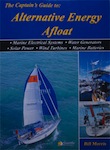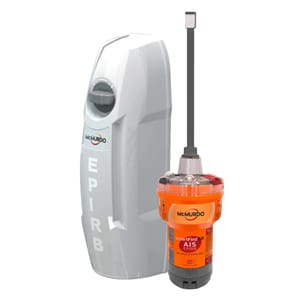Since emergency position indicating radio beacons (EPIRBs) made their debut as an aid for tracking crashed U.S. military aircraft in the 1950s, this technology has steadily evolved into more compact, highly accurate, life-saving devices priced well within the budget of any serious cruising sailor.
Today, even the humblest of coastal cruisers make sure their vessels are equipped with the familiar little yellow or orange plastic device that can mean the difference between being found alive or coming to rest in Davy Jones’ Locker.
Though we sailors are accustomed to choosing from a wide assortment of manufacturers in a given product field, the EPIRB industry appears to be dominated, if not exclusively inhabited, by three manufacturers of this important technology: ACR Electronics, McMurdo and Ocean Signal.
ACR Electronics’ GlobalFix iPRO EPIRB is the flagship of ACR’s line of vessel and personal EPIRBs. The GlobalFix iPRO’s dual GPS technology permits you to link your EPIRB with the vessel’s GPS to ensure the first signal burst transmits your GPS coordinates to geostationary satellites via 406 MHz signal as well as the 121.5 MHz homing frequency.
This EPIRB also features an LCD digital display of your GPS coordinates, along with step-by-step operator instructions — a far cry from the “beep” prompts and LEDs of yesteryear. At about $500, ACR’s GlobalFix iPRO is $300 less than I paid for an earlier version of the ACR EPIRB more than 20 years ago, and it offers much more crew-friendly operability than its earlier versions. What’s more, the unit is also about a third smaller than before, its environmentally safe battery runs the unit for 65 hours and it keeps its charge for six years.
The McMurdo SmartFind G8 Automatic EPIRB is a revolutionary device: It’s the first to combine both AIS and GPS, in addition to tracking and homing signals, for faster tracking by ships and satellites offshore. This combined technology makes sure your location is being tracked not only by satellites but also by passing ships as soon as the unit hits the water. And to top it off, its lithium iron disulphide battery will last 10 years before requiring replacement.
Without question, you have a much better chance of being plucked from the deck of your stricken vessel with this device than with the lower-priced competitors. The Rolls-Royce of EPIRBs, the McMurdo SmartFind G8 is also the priciest at a little more than $1,000, but the added life-saving features are well worth the extra dent in your cruising kitty.
For about $200 less, you can buy the manual version of this McMurdo device. As long as someone is awake to switch it on, this slightly smaller EPIRB offers the same advantages as the automatic version. By the way, the McMurdo EPIRBs are not for sale in California. I guess I’ll have to drive to Arizona to buy one.
The Ocean Signal rescueME EPIRB1 is the least costly of the three competitors, setting you back a mere $400 while offering essentially the same features as the ACR GlobalFix iPRO. This device features 10-year battery life, 66-channel GPS, 406 MHz signal with 121.5 MHz homing frequency, and a minimum 48 hours of battery life when deployed.
A unique feature of the rescueME is a pair of extremely bright strobe lights, which operate together to add greater visibility at night should the vessel’s circuitry shut down from main battery failure.
After purchasing a new EPIRB and installing it on your vessel, remember that international law requires you to register your beacon code with your country. In the U.S., you may register the device online at www.beaconregistration.noaa.gov/.
 |
Circumnavigator-author Bill Morris is the author of The Captain’s Guide to Alternative Energy Afloat and is a frequent contributor to Ocean Navigator.

